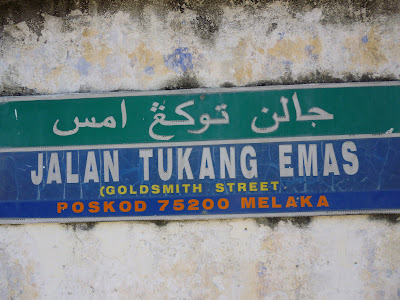La semana que pasamos en Koh Tao disfrutando del placer de no hacer nada hizo que tuviéramos que darnos más prisa en Malasia, centrándonos en las ciudades y dejando de lado los parques naturales. Hubiera sido un tremendo error de no ser por Melaka.
Como siempre, el centro neurálgico de la ciudad era Chinatown, con sus característica cultura baba nonya, mezcla de chin@s y malay@s. Lo más interesante era encontrar en la misma calle una mezquita, un templo chino, un templo hinduista y una iglesia (en bahasa "gereja", herencia del portugués "igreja", curioso).
Por otro lado, el ambiente colonial con el monumento a la reina Victoria, el Stadthuys (ayuntamiento en holandés) y la iglesia de San Pablo y la puerta famosa ("A Famosa" en portugués) terminaba de darle el toque pintoresco a esta ciudad declarada Patrimonio de la Humanidad por la UNESCO.
Por otro lado, el ambiente colonial con el monumento a la reina Victoria, el Stadthuys (ayuntamiento en holandés) y la iglesia de San Pablo y la puerta famosa ("A Famosa" en portugués) terminaba de darle el toque pintoresco a esta ciudad declarada Patrimonio de la Humanidad por la UNESCO.
Aunque algo de mala suerte tuvimos al ir a parar a la ciudad en fin de semana. El casco antiguo estaba lleno de grupos de turistas chin@s que copaban todos los locales de comida: las colas daban la vuelta a la manzana en los establecimientos recomendados por las guías.
Consejo viajero: el palacio del sultanato, que se puede visitar por un euro, es una auténtica basura, salvo que os gusten los maniquíes como este.
The week we spent in Koh Tao enjoying the pleasure of doing nothing forced us to be in a hurry in Malaysia, focusing on the cities instead of the natural parks. It would have been a big mistake if it hadn't been for Melaka.
As always, the downtown was Chinatown, with its characteristic baba nonya culture, a mix of Chinese and Malay. The most interesting thing was finding in the same street a mosque, a Chinese temple, a Hindu temple and a church ("gereja" in Bahasa, heritage of the Portuguese "igreja", curious).
On the other hand, the colonial feeling with the monument to Queen Victoria, the Stadthuys ("city hall" in Dutch) and Saint Paul's Church and the famous gate ("A Famosea" in Portuguese) ended up giving a pittoresque touch to this city declared World Heritage by the UNESCO.
However we weren't very lucky arriving on the weekend. The old city was crowded with groups of Chinese tourists that filled all the restaurants: the queues were endless in the places recommended by the guide books.
Tip for travellers: the Sultanate Palace, that can be visited for one euro, is a complete loss of time, unless you like mannequins like this one.
On the other hand, the colonial feeling with the monument to Queen Victoria, the Stadthuys ("city hall" in Dutch) and Saint Paul's Church and the famous gate ("A Famosea" in Portuguese) ended up giving a pittoresque touch to this city declared World Heritage by the UNESCO.
However we weren't very lucky arriving on the weekend. The old city was crowded with groups of Chinese tourists that filled all the restaurants: the queues were endless in the places recommended by the guide books.
Tip for travellers: the Sultanate Palace, that can be visited for one euro, is a complete loss of time, unless you like mannequins like this one.






















































